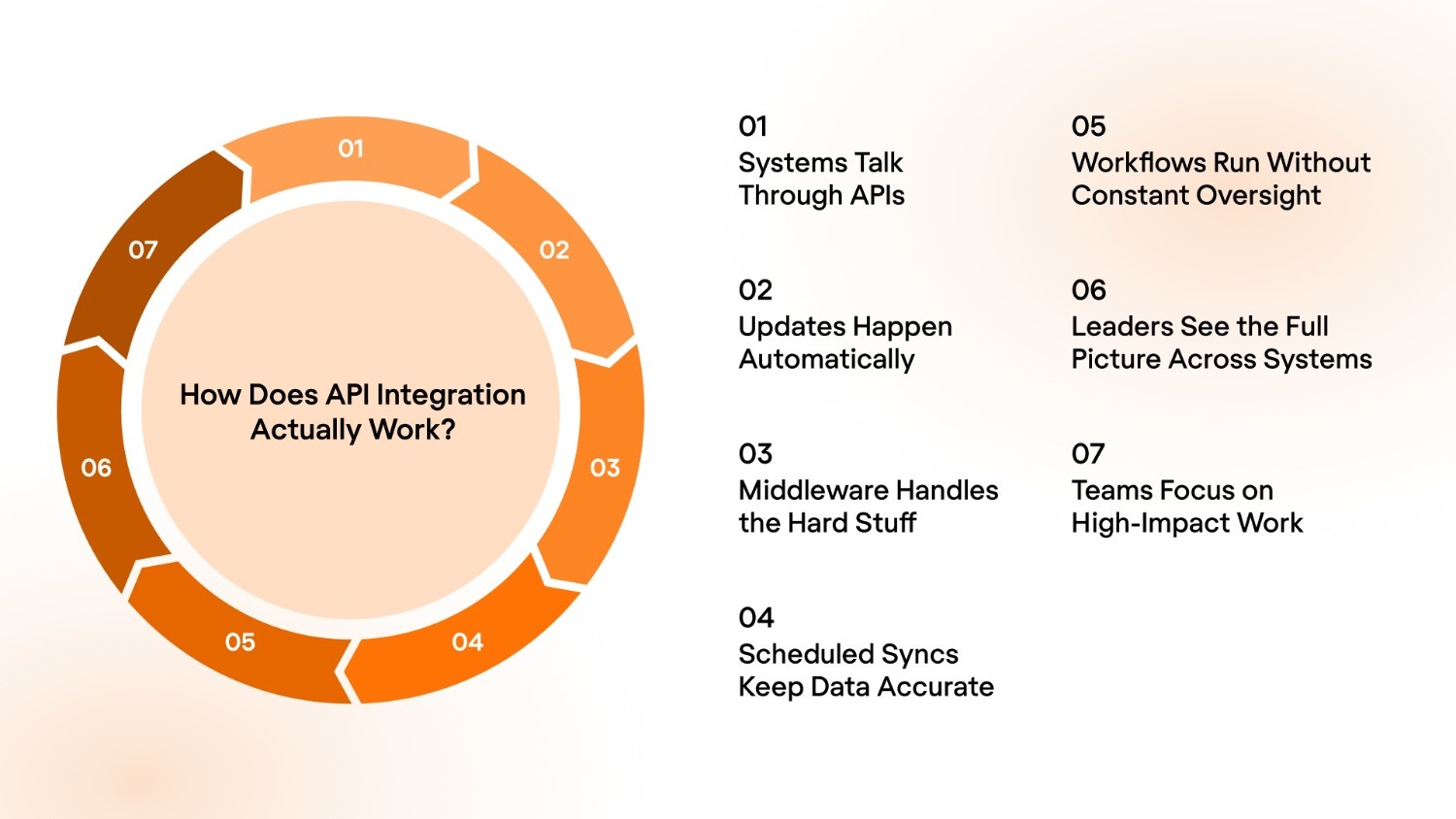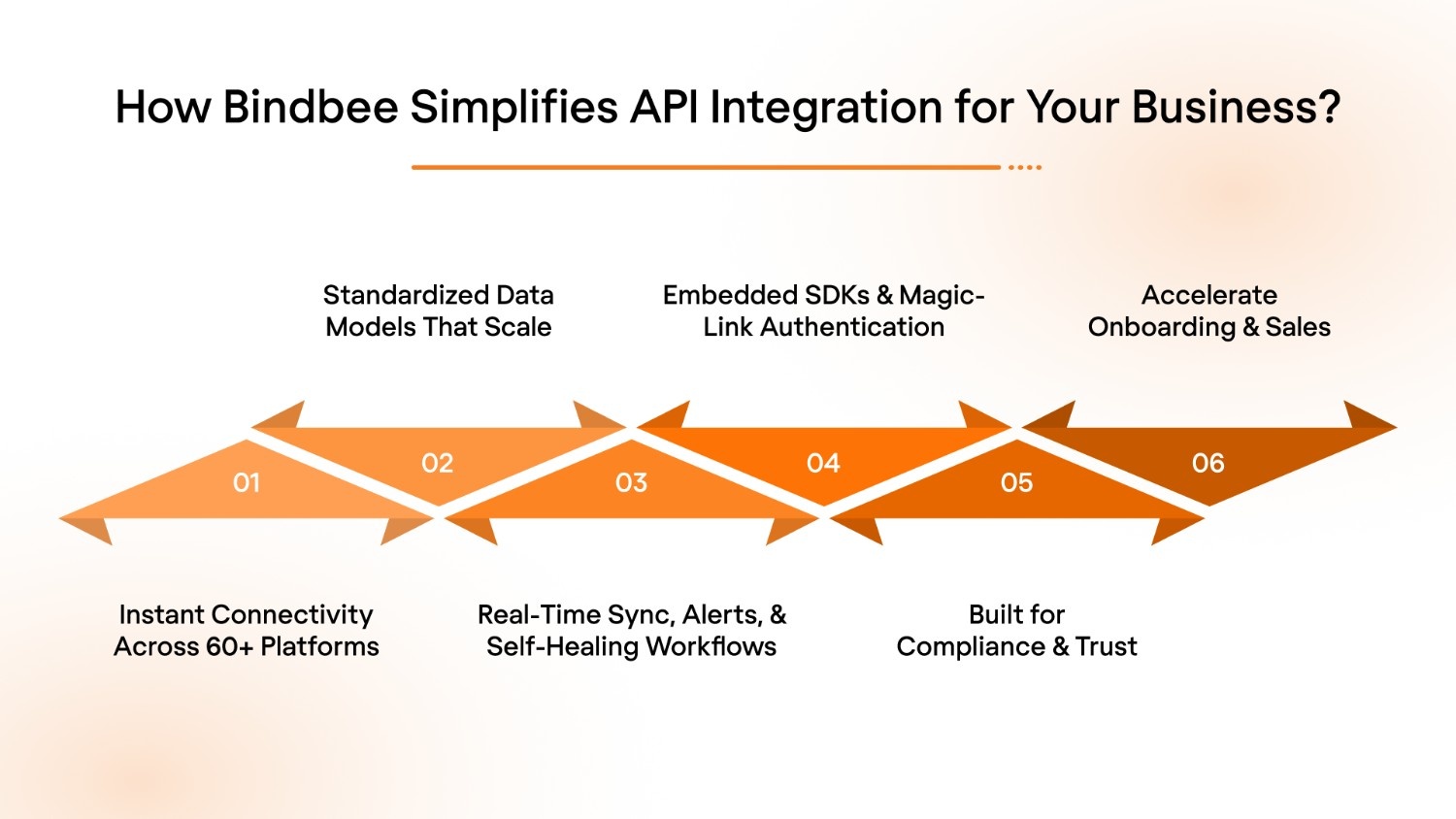Getting HRIS, payroll, and benefits platforms to work together can be a nightmare. Each system has its own APIs and quirks, leaving engineers stuck building one-off connections, operations teams fixing errors, and sales waiting on setups before deals close.
API integration solves this by connecting systems through a single interface. Workflows automate themselves, data flows in real time, and your teams get visibility without pulling engineers off core projects.
According to the Postman 2025 State of the API Report, 43% of fully API-first organizations generate more than a quarter of their revenue through APIs, showing that smart integration can directly impact growth.
In this guide, we’ll walk through the top 9 benefits of API integration, the types of integrations you can implement, and what effective deployment looks like in practice.
Key Highlights:
- API integration eliminates manual reconciliation across HR, payroll, and benefits systems, ensuring real-time data accuracy.
- Unified APIs reduce engineering workload by replacing multiple one-off builds with a single, scalable connection.
- Secure, compliant data transfers protect sensitive employee and payroll information across systems.
- Automated workflows improve collaboration, compliance, and decision-making through clean, connected data.
- Scalable integrations enable faster innovation, supporting new tools, AI systems, and business growth without disruption.
Understanding API Integration and Its Key Types
API integration is what keeps your business systems talking without constant manual work. HR platforms, payroll tools, benefits software—they all collect valuable data, but out of the box, none of them naturally sync. Without integration, your team spends hours reconciling records, fixing errors, or waiting on updates instead of building products or supporting employees.
A good API integration makes data flow automatically, keeps workflows consistent, and surfaces problems before they slow you down. It’s not just connecting systems—it’s making your tech stack work as a single, reliable engine.
Here’s how companies usually do it:
- Point-to-Point Integration: Connects two systems directly. Updates in one system show up in the other automatically. It’s fast to set up, but becomes messy as you add more systems.
- Hub-and-Spoke Integration: Adds a central hub to manage multiple connections. Systems don’t need separate links to each other, so maintenance is easier and control is centralized.
- Cloud-Based Integration Platforms (iPaaS): Uses prebuilt connectors and cloud tools to link multiple applications. Operations teams can manage workflows without heavy developer involvement, and updates happen in real time.
- Unified API Integration: Integrates once and connects multiple systems through standardized data models. Reduces engineering effort, keeps workflows stable, and accelerates onboarding for complex HR, payroll, and benefits setups.
When done right, API integration turns a patchwork of tools into a smooth, reliable system. Data flows where it should, workflows stay intact, and your team can focus on what actually drives the business.
How Does API Integration Actually Work?
APIs are the engine that keeps your systems aligned and your teams moving. In practice, integration connects platforms like HR, payroll, and benefits so updates happen automatically, without engineers babysitting every transfer or operations chasing errors.
Here’s how it works:

1. Systems Talk Through APIs
Each platform exposes endpoints that let other systems request or push data in a structured, predictable way. This ensures updates are consistent and accurate.
2. Updates Happen Automatically, Not Manually
Data such as employee information, payroll details, or benefits enrollments move seamlessly between systems. Managers see real-time dashboards, finance avoids reconciliation headaches, and engineers aren’t stuck fixing misaligned fields.
3. Middleware Handles the Hard Stuff
Integration platforms or middleware manage authentication, error handling, and data transformation. They ensure that even if systems speak slightly different “languages,” information is delivered correctly.
4. Real-Time or Scheduled Syncs Keep Data Accurate
Updates can happen instantly or in batches, depending on business needs. This ensures critical data like payroll contributions or benefits elections are always accurate and up to date.
5. Workflows Run Without Constant Oversight
Integrations orchestrate end-to-end processes. Manual CSV exports, error reconciliation, and repeated updates are eliminated, giving teams a single source of truth and reducing operational risk.
6. Leaders See the Full Picture Across Systems
With robust integrations, leaders get actionable insights across platforms. Teams can scale processes without introducing fragile workflows or disrupting existing operations.
7. Teams Focus on High-Impact Work
By automating data flow and error handling, your teams spend less time firefighting and more time on strategic projects, innovation, and employee experience improvements.
Suggested Read: API vs Integration: The Differences and Intersections
How Do You Benefit From API Integration?
Legacy systems often worked in silos, relying on manual imports, file uploads, or error-prone syncs. That was fine when data moved slowly, but not when operations depend on real-time accuracy.
API integration changes that. It creates a unified system where data moves instantly, updates are reliable, and teams stop wasting time on fixes and rework.
Here’s what that actually looks like when it all clicks:
Let’s take a closer look at what each benefit really means.
1. Make Every Experience Seamless, Inside and Out
When data flows automatically, employees and customers see the same accurate information in real time. That means fewer errors, faster updates, and more trust.
Example: An HR tech platform can instantly sync PTO balances across payroll and benefits tools, so employees always see the correct leave data.
Key Impact: Consistent employee and payroll data across systems; reduced mistakes in deductions or benefits.
2. Run Leaner, Faster, and More Efficiently
Automation takes care of repetitive work like data entry or file uploads, giving your team more time for high-value tasks.
Example: Payroll deductions update automatically across multiple benefits plans. No manual spreadsheets required.
Key Impact: Reduced manual effort, faster processing, and improved operational bandwidth.
3. See Everything. Fix Faster. Decide Smarter.
Connected systems give you a real-time view of what’s working and what’s not. Spot issues early, fix them faster, and make decisions backed by data.
Example: Ops managers receive instant alerts when payroll syncs fail, fixing issues before pay runs go out.
Key Impact: Enhanced reporting, proactive issue resolution, and data-driven strategy.
4. Protect Sensitive Data with Built-In Security
Every integration carries risk — but secure APIs minimize it. Encrypted connections, access controls, and audit logs ensure sensitive employee and payroll data moves safely between systems.
Example: Payroll data transfers through token-based authentication with automatic encryption, reducing exposure to breaches or leaks.
Key Impact: Stronger data protection, reduced compliance risk, and full visibility into every sync.
5. Get Teams Talking, Not Waiting
When everyone works with the same data, collaboration becomes effortless. No more chasing spreadsheets or waiting for updates.
Example: HR, payroll, and benefits teams access real-time employee contribution data from a single source.
Key Impact: Reduced communication gaps, improved cross-team efficiency, and smoother partner interactions.
6. Keep Every Record Clean and Compliance-Ready
Clean data drives compliance and confidence. APIs keep every record in sync, so information is always current and consistent.
Example: When a new hire is added to your HRIS, their details update automatically across payroll and benefits platforms.
Key Impact: Fewer errors, improved compliance, and higher trust in your data.
7. Cut Integration Costs Without Cutting Corners
APIs eliminate the need for costly, one-off custom builds that drain engineering time. With a single unified connection, you can connect multiple systems reliably and maintain them with ease.
Example: Instead of building and maintaining separate integrations for each HR or payroll tool, a unified API handles them all.
Key Impact: Lower maintenance costs, reduced engineering hours, and faster deployment without sacrificing reliability.
8. Grow Without Rebuilding Your Stack
As your business expands, API integrations scale with you. Add new tools or vendors without breaking existing workflows.
Example: Adding a new benefits provider automatically connects to payroll and HR systems, saving weeks of setup time.
Key Impact: Seamless growth, easier onboarding, and scalable processes.
9. Stay Ready for What’s Next
Technology moves fast — your integrations should too. APIs make it easy to adopt new tools, automate workflows, or connect with AI-driven platforms.
Example: Implementing an AI-based benefits recommendation engine takes days, not months, because the data is already synced.
Key Impact: Faster innovation cycles, simpler adoption of new tools, and readiness for emerging tech.
Suggested Read: 15 API Integration Platforms Every Business Should Know
Knowing the benefits of API integration is one thing. Making them real in your product is another. Bindbee bridges that gap with unified, ready-to-use integrations that eliminate months of backend work, so you can deliver connected experiences faster.
How Bindbee Simplifies API Integration for Your Business
Bindbee’s unified HR/payroll API is designed to remove the engineering and operational burden of building and maintaining multiple connectors.
Here’s how we can help you:

- Instant Connectivity Across 60+ Platforms: Access major HRIS, ATS, and payroll systems like Workday, ADP Workforce Now, Gusto, Rippling, and BambooHR out of the box. Built-in SFTP adaptors handle legacy vendors, saving months of integration development.
- Standardized Data Models That Scale: Bindbee supports 15+ unified models per integration, covering core HR and payroll objects like employees, time-off, compensation, dependents, and pay groups. This ensures clean, consistent records across connected systems.
- Real-Time Sync, Alerts, and Self-Healing Workflows: Event-driven webhooks, automated retries, and self-healing syncs keep your data up-to-date with minimal manual intervention. Operational dashboards highlight sync issues instantly, so non-technical teams can act fast.
- Embedded SDKs and Magic-Link Authentication: Integrate employer connection flows directly into your product. With a branded, one-click experience, customers can link their HR/payroll tools in minutes instead of days.
- Built for Compliance and Trust: Bindbee is SOC 2 and ISO 27001 certified, with HIPAA support, GDPR-readiness, and standard legal frameworks to meet enterprise security expectations.
- Accelerate Onboarding and Sales: Prebuilt mappings and operational tooling reduce customer setup from weeks to hours — helping your go-to-market team close deals faster and onboard new accounts without blocking engineering.
The result: a single, reliable API layer that keeps your integrations consistent, compliant, and easy to scale.
The Smarter Way to Power Your Integrations
Manual updates, disconnected systems, and error-prone workflows slow your operations and add hidden costs.
Bindbee solves this. With 60+ prebuilt HR, payroll, and benefits connectors, real-time syncing, and embedded automation, it takes the hassle out of integrations so your team can focus on product innovation, customer experience, and growth.
Book a demo today and see how fast integration can be.
FAQs
1. What are the four main benefits of using REST APIs?
The four main benefits of REST APIs are scalability, flexibility, simplicity, and performance. REST APIs use standard HTTP methods, making them easy to implement and integrate with various platforms. They scale efficiently as your system grows and allow developers to reuse and extend existing services with minimal overhead.
2. What is the main advantage of an API?
The main advantage of an API is that it enables seamless communication between different software systems. APIs eliminate the need for manual data exchange or custom-built connectors, helping businesses automate workflows, improve accuracy, and accelerate innovation.
3. What are two benefits of using APIs and integrations between applications?
Two key benefits of using APIs and integrations are data consistency and operational efficiency. APIs ensure that all connected systems share real-time, accurate data while reducing manual work through automation, leading to faster processes and fewer errors.
4. What are the advantages and disadvantages of APIs?
Advantages: APIs save development time, enable automation, support scalability, and enhance user experiences through interconnected systems.
Disadvantages: They require ongoing maintenance, security oversight, and version management to ensure reliable performance as systems evolve.
5. What are the common challenges companies face when implementing API integration?
Key challenges include system incompatibility, inconsistent data formats, security risks, and integration complexity. Businesses may also struggle with high development costs, limited monitoring, and long-term maintenance.





.png)

.png)

.jpg)



